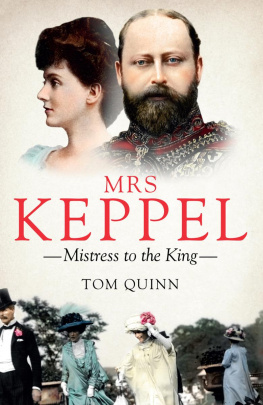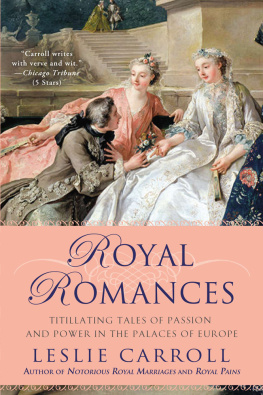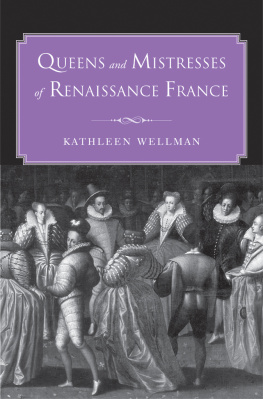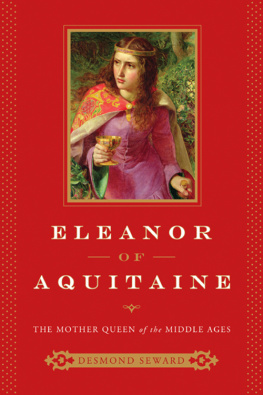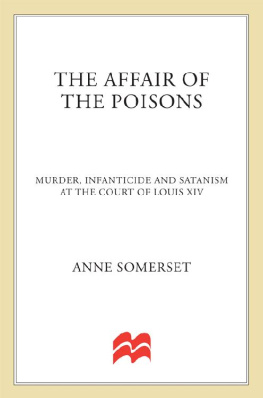
I should like to thank Professor Anthony Nuttall of New College, Oxford, for his excellent advice, without which this book would never have been attempted. Many thanks, too, to Michael Alcock, at Michael Alcock Management, for endless encouragement and faith in the book. Alan Samson at Time Warner Books has been equally kind, and I am very grateful, as I am to my editor, Caroline North, whose patience and diligence have been so overwhelming that any remaining errors in the book are entirely mine. Linda Silverman was wonderful at tracking down pictures from all over Europe. Kinch Hoekstra, of Balliol College, was also kind enough to provide some obscure material: thanks for easing the tension. Without the scrupulous and dedicated attention of Asya Muchnick, this book might have proved as exasperatingly elusive as its subject. I am extremely grateful for her scholarly discernment. Thanks to Jack Murnighan, for Florence. Most of all, I would like to thank Dominique de Bastarrechea, for more inspiration, goodness and delight than I or this book can ever deserve.
M any of the primary sources that must be drawn upon in any reconstruction of the life of Athnas de Montespan are considered in their own right to be some of the most important works of French literature of the seventeenth century. As such, they are not merely factual reportage, but subject to the same complexities of interpretation as might be applied to novels or plays. Academia speaks, for example, of Svignen poetics in describing a particular type of subjective language, while Saint-Simons unusual manipulations of seventeenth-century French suggest that he was engaged as much on a work of art as on a gazette of his age. The reader must therefore be alert not only to factual discrepancies in the work of the writers of letters or memoirs, but also to the peculiar subjectivity of the authors, their personal motivations and characters, and the location of both letters and memoirs within a very specialized genre of communication which can be as expressive of the changing nature of the French language as it is of the events of the French court.
Letters and memoirs are obviously defined stylistically by the cultural climate in which they are produced, and their function can alter accordingly. In Mme. de Svigns letters, for example, it is possible to discern a change in register between the relatively intimate communication of her correspondence with her daughter, Mme. de Grignan, and the more public letters, to Bussy-Rabutin, for instance, which were written to be read aloud or shared, and therefore have a more dramatic tone, stagey descriptions and flamboyant language. Since even personal writing was performative and carefully designed to display the intellectual qualities and esprit of the writer, such sources cannot be taken at face value. The influence of the cultivated language of the salons meant that linguistic skill was linked to a moral capacity; honntet was demonstrated in the elegant use of words. The vogue for the pen portrait meant that even private descriptions of personalities were flavored by a need to conform to a certain style.
The bulk of memoirs in seventeenth-century France were written by men, with the notable exceptions of Mademoiselle, Mme. de Longueville, Mme. de Motteville and Mme. de la Guette, and they were frequently written partly or wholly after the events they record, which meant they could be polished to form a coherent narrative to present to the world. So vivid are the Duc de Saint-Simons descriptions of the court of Louis XIV that it is easy to forget that he did not arrive there until 1691, and was therefore not an eyewitness to many of the events he detailed. Athnas de Montespan was little more than a memory at Versailles for almost all of the time Saint-Simon spent there. His personal agenda, and its political implications, are clear in his memoirs: he was committed to the ideal of a ruling aristocracy based on birth which had ceased to have any political potential after the suppression of the Fronde. So he loathed the snobbish aspirations of the noblesse de robe, believing emphatically in the social hierarchy ordained, in his view, by God, and his respect for the King was greatly tempered whenever he felt that Louis was betraying his kingly role by encouraging parvenus, or when Louiss autocratic ambition came into conflict with what Saint-Simon saw as the essential privileges of his class. The Duc was critical of anyone who offended his sense of the rightness of the social order, but he was also pious, hence his particular loathing for Athnas de Montespans children, whose elevation was not only a glorification of a sin against the holy sacrament of marriage but an insult to the aristocracy from which he came.
Saint-Simons memoirs can be read as a political manifesto, in that they invoke an ideal of government based on a monarch and a strong aristocracy that he hoped to see realized in the reforms of the next reign. Vincent Cronin suggests that one can be fair to Louis only by treating with extreme caution the writings of a man so hostile to the King, and if hostility seems too strong a word for what was clearly a troubled fascination, Saint-Simons criticisms of Louis must nonetheless be read in the light of his attempts to bolster the new order of the Regency under his friend Philippe dOrlans. This might not seem terribly relevant to the Ducs assessment of Athnass character, but in dwelling upon her vanity and pride, Saint-Simon is criticizing a social revolution (the legitimization of her children and their inclusion in the succession) that offended his most profound beliefs. It is testament to Athnass famous charm, then, that Saint-Simon is able to overcome his loathing of the royal bastards to describe it at all.
Mademoiselles memoirs, though created rather more spontaneously than Saint-Simons, in three periods around 1660, 1677 and 168990, had just as much of a personal agenda. In her account, the Lauzun affair, as well as her involvement in the Fronde, are vindicated for posterity. The famous incident when she had the cannon of the Bastille turned upon the royal troops, to protect the Frondeurs, led by the Prince de Cond, is lengthily considered, and Mademoiselle is unable to suppress her satisfaction at her own heroism, even as she tries to attribute her actions to the weak prevarication of her father, Gaston dOrlans. Even though it took some time for the truth to emerge, when it did she was never able to forgive Athnas de Montespan for her involvement in the conspiracy to prevent her own marriage to Lauzun, or to take into consideration the fact that Athnas was just as much a victim of Louiss deceitfulness in the business as she was. Mademoiselles justification of her own actions was sufficiently critical of the regime for Philippe dOrlans to ban her memoirs when they appeared in 1718 and, like Saint-Simon, she must be read with an awareness of a subtext.
Both Saint-Simon and Mme. de Svign have been used as sources and models for subsequent French writers, perhaps most famously by Proust in A la Recherche du Temps Perdu. He compares the style of Mme. de Svigns letters to the painting of the artist Elstir, suggesting that she is absorbed by the personal, subjective qualities of a situation and disregards its reality as perceived by others. Her subjectivity, Proust proposes, had nothing of the communal to it. It is concerned with creating an affective world, constructed from what acts upon the senses of the individual. Again, such a rarefied reading of Mme. de Svign might not seem relevant to her eager reportage of Athnas de Montespans triumphs and decline, but this interpretation emphasizes the specialized individualism that makes Mme. de Svigns letters such an important literary work and such a problematic historical source. In a sense, her subjectivity presents an opposite problem from Saint-Simons in that many of her letters were in a sense love letters, stemming from the urgent need to communicate with her daughter, whom she loved in a way that seems positively sinister to modern psychology, and not designed as a chronicle to be admired by posterity. Whether the Svignen tone is seen to be compromised by its intimacy or by its performative qualities, the relationship between the author of the letters and their recipients prevents them from ever being relied upon as an entirely objective historical source.



